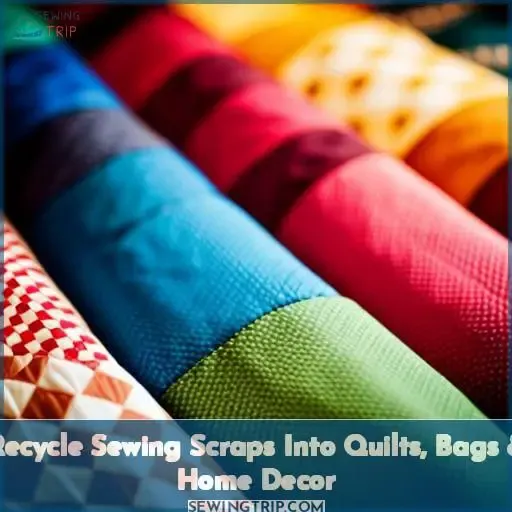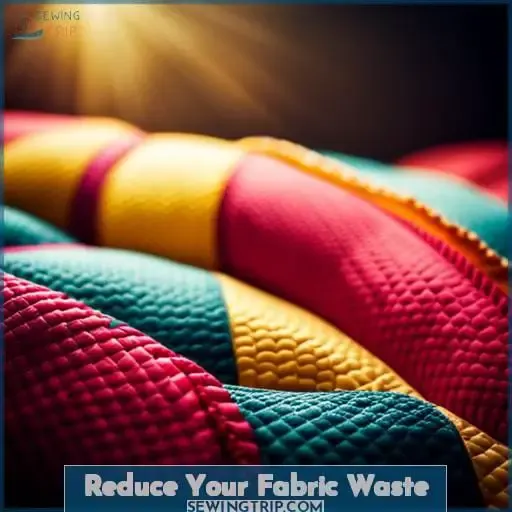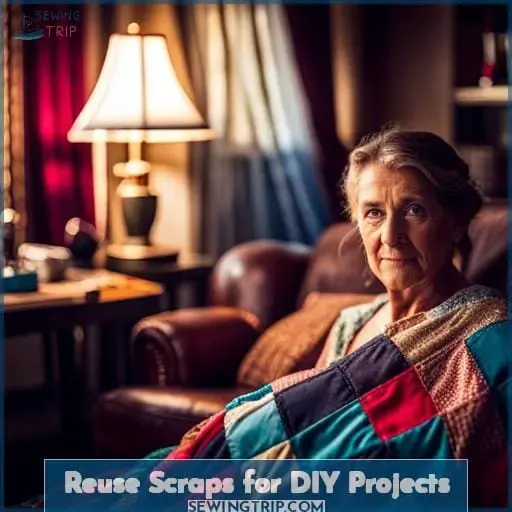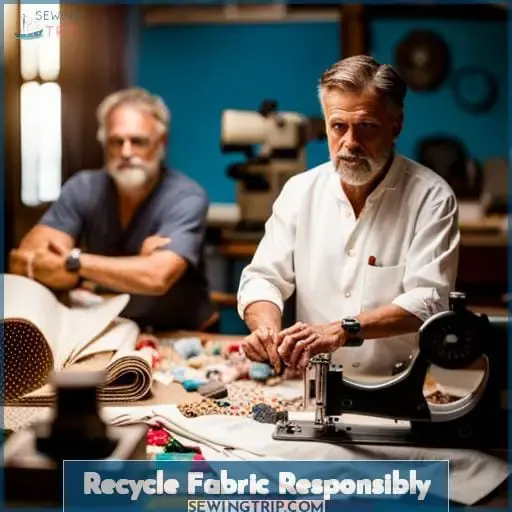This site is supported by our readers. We may earn a commission, at no cost to you, if you purchase through links.

Their colors, patterns and textures weave together not only material but community.
Don’t let them go to waste. Give them new life through donation, recycling or upcycling. Join this movement of mindful makers stewarding resources. With needle and thread, you stitch sustainability and belonging.
Collectively, our actions empower change. How will you reuse, recycle and renew the scraps your sewing leaves behind? This path reconnects fabric to purpose, people to planet.
Table Of Contents
Key Takeaways
- Focus first on reusing and repurposing your fabric scraps before considering other options.
- If you can’t reuse them yourself, consider donating clean scraps to schools, thrift stores, or textile recycling programs.
- Learn about textile recycling options and their environmental impacts before utilizing them.
- Within your community, spread awareness about sustainable fashion and textile recycling.
Reduce Your Fabric Waste
Look within before buying more. First, pull fabrics from your stash, then purchase remnants, or even try thrifted finds before buying yardage.
Buy Less and Care for Clothes
You’d be wise to purchase only the fabric you require and care for your clothes to lessen waste. Mend clothing you already have. Follow sustainable wardrobe advice like hand washing delicates and air drying clothes to prolong their lifespan.
Backlash against fast fashion’s consequences through eco-conscious buying and donating still-wearable clothes. Ultimately, reducing textile waste starts with thoughtful buying and caring for the textiles you do obtain.
Look into textile recycling groups locally and reuse fabric scraps to minimize environmental impact.
Use Your Fabric Stash First
Before buying new, dip into your fabric stash first. Did you know the average American discards 82 pounds of textiles each year?
By sorting and organizing your fabric collection, you may uncover unused treasures. Get creative with remnants – combine patterns or make accessories. Reduce waste by fully utilizing yardage. Give new life to scraps with patchwork or quilting. Let your imagination hold the sustainability key.
Extend your materials’ lifespans through mindful use and care; you’ll save money too.
Purchase Fabric Remnants
Look for remnants and discounted fabrics when restocking your stash. Remnant fabric saves money for creative projects while reducing waste. Remnant hunting becomes a sustainable adventure when eco-friendly fabric bargains are found.
Green sewing means purchasing fabric remnants or textile scraps to recycle into handcrafted treasures. Seeking bargain fabrics and remnants helps reduce your footprint when sewing sustainably.
Purchasing remnants and discounted fabrics is a great way to save money and reduce waste when restocking your fabric stash. Hunting for remnant bargains can be a fun, sustainable adventure when you find eco-friendly fabrics at great prices.
Choosing fabric scraps and remnants for your sewing projects allows you to recycle materials into handmade items and is a green, sustainable habit. Seeking out bargain remnants helps shrink your environmental footprint when sewing in an eco-conscious way.
Reuse Scraps for DIY Projects
Rather than tossing fabric remnants and swatches in the trash, you can extend their useful life through upcycling! Quilts, tote bags, potholders, and other home decor crafts allow for creative reuse of scrap fabrics that would otherwise wind up in the waste stream.
Reusing these fabric scraps for DIY projects keeps them out of landfills. Whether you sew, knit, weave, or craft in some other way, repurposing your extra bits of fabric helps the environment.
Quilts and Bags From Scraps
Consider putting those fabric scraps to good use by crafting homemade quilts as cozy as a warm blanket fresh from the dryer. Transforming remnants into charming quilts or sturdy market bags breathes new life into worn out textiles.
Clever scrap utilization for sewing projects like patchwork quilts, tote bags, pouches and more allows creative recycling. These sustainable crafts minimize waste while producing handmade treasures from salvaged fabric scraps.
Repurposing techniques let you avoid tossing out or trashing leftover textile waste.
Home Decor Projects
Why not upcycle some fabric scraps into cute home decor pieces like pillows or wall art?
There are creative ways to repurpose those fabric scraps:
- Make DIY throw pillow covers from the remnants.
- Collage the scraps into interesting wall art.
- Stitch soft fabric baskets for storage.
- Sew potholders and oven mitts from the leftover materials.
Giving fabric scraps new life in home decor reduces waste and results in unique, eco-friendly pieces.
Recycle Fabric Responsibly
Have leftover fabric scraps after your latest sewing project? Consider donating them locally or looking into mail-in recycling programs. Schools, community centers, and even some thrift stores may accept fabric remnants, allowing your scraps to find creative reuse while keeping textiles out of landfills.
Donate Scraps Locally
You’d do well to gift your leftover bits of fabric to nearby schools, thrift shops, or charities for them to responsibly recycle. Handing fabric scraps off to local schools, churches, or creative groups lets materials find new life in your community’s hands.
Charity shops often welcome fabric remnants and worn clothes for their textile recycling programs.
Mail-in Recycling Programs
Across the country, textile recyclers offer mail-in programs sending your scraps off for reusing. Mail-in recycling is widely available making it easy to track waste reduction while helping sustainable practices.
Choices include eco-friendly options like Fabscrap.com or Terracycle.com, serving communities focused on fabric disposal away from landfills. Explore recycling locations like Re-loom.org accepting textile waste, giving scraps new life.
Upcycle Old Clothes
Transform your old clothes into one-of-a-kind creations with these easy upcycling tips. Instead of tossing worn or damaged garments, breathe new life into them by repurposing fabric scraps into everything from tote bags and quilts to hair scrunchies and rag rugs.
Sell, Donate, or Repurpose Clothes
You could declutter your closet by giving gently worn pieces new life at a consignment shop or with crafty homemade projects.
- Donate quality clothes to charity shops like Goodwill or the Salvation Army for sale at low prices.
- Consign high-end pieces to stylish resale boutiques.
- Host a clothing swap party with friends and family to recycle wardrobes.
- Try sewing projects such as pillows, hair scrunchies, and reusable shopping bags from old t-shirts and jeans.
Sew New Items From Old Clothes
Creative reuse can prolong a garment’s lifecycle, as even the smallest scrap of fabric holds untapped potential. By repurposing clothes through makeovers and sustainable sewing projects, worn items experience imaginative transformations.
Reimagining tired clothing sparks inspiration for fashion upcycling, reducing waste in the process. Stitching fabric scraps into colorful patches or braided rag rugs imbues castoffs with renewed purpose and vitality.
Show your clothes some love by reinventing tired pieces into cherished keepsakes.
Encourage Sustainable Living
Let’s do our part to support sustainable living and keep those fabric scraps from ending up in landfills! There are many creative ways for repurposing scraps, from donating them to schools or craft groups to exploring zero-waste patterns and buying only what we need for projects.
Reduce Environmental Impact
Sorting your cast-off textiles into categories like wearable, reusable, and recyclable can reduce your fashion footprint. Be selective when purchasing fabrics and avoid excess. Upcycling scraps into quilts, bags, rugs, or donating to local schools and craft groups is another option.
Supporting ethical companies that recycle textiles responsibly is also impactful.
Support Responsible Recycling
Before you donate anything, explore programs that responsibly recycle textiles. Support eco-conscious companies collaborating with thrift shops to give fabric scraps new life. Consider local upcycling initiatives first. Weigh the environmental impact of recycling options – some have hefty carbon footprints.
Promote zero waste fashion in your community. Advocate for responsible textile recycling that serves people and the planet.
Conclusion
You may feel overwhelmed when trying to reduce fabric waste, but small steps make a significant difference. Focus on reusing and repurposing what you already have. Upcycle old clothes into new creations.
Support textile recycling programs in your community. Encourage sustainable living by spreading awareness.











